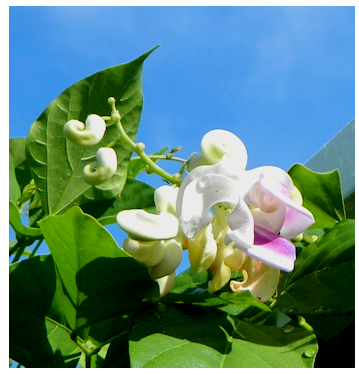Grow Corkscrew Vine
 The lovely and unusual Corkscrew Vine is often mislabelled as phaseolus, which is actually a relative of the Corkscrew vine, but is much more aggressive and lacks fragrance. The Corkscrew vine, or Vigna Caracalla, is a bit more sensitive, much easier to control, and the blooms are multi-colored. Shades of cream, muave, pink, shell, lavendar and pale yellow can all grace the vine at one time.
The lovely and unusual Corkscrew Vine is often mislabelled as phaseolus, which is actually a relative of the Corkscrew vine, but is much more aggressive and lacks fragrance. The Corkscrew vine, or Vigna Caracalla, is a bit more sensitive, much easier to control, and the blooms are multi-colored. Shades of cream, muave, pink, shell, lavendar and pale yellow can all grace the vine at one time.
Over Winter Corkscrew Vine
Vigna Caracalla is native to Central and South America. Down here in South Florida, it is an evergreen. The delicate leaves are tri-lobed. In agricultural zones 8 and lower, the corkscrew vine must be protected from frost.Corkscrew vine creates a large, underground tuber. If your area receives heavy frost, you can dig the tuber up before the threat of first frost and over winter indoors. Just as you see daffodil and narcissis bulbs, you can bury it in clean wood shavings until spring. Sphagnum moss can also be used. Store in a cool, dark place during it's dormancy. You can also store it in slightly moist soil.
Soil and Fertilizer Care of Corkscrew Vine
Corkscrew vine grows well in a rich, loamy, loose and deep soil with added compost. I try to keep the soil slightly moist, and fertilize it with MiracleGro regular (blue) water soluble fertilizer every two weeks according to package directions.
My own plants bloom anywhere from early summer to late fall. If they are from seed early enough in the season, they can bloom the same year.
Training Corkscrew Vine
Corkscrew vines are easy to train onto a trellis or fence. This plant does not grow as quickly as it's cousin the snail vine, but don't think that's discouraging. You won't be trimming it as often. It blooms readily on the new green wood, so pruning is a good thing.
Corkscrew vine starts out with tender, green stems, that will harden up to a thick, brown wood. While they are still soft and green, train them around and through your trellis or fence. After they harden, this will not be possible.
My vigna caracalla vines rarely reach any longer than 20 feet each direction, but I do keep them trimmed up.
How to Propagate, Grow Seeds of Corkscrew Vine
 Ants pollinate Vigna Caracalla, so if you want seeds, don't kill or remove them. They are able to crawl into the coiled flowers, and reach the inner sexual organs of the plant, which will then give you a bean shaped pod. Wait until it dries (turns brown) before cracking it open and retreiving the seeds.
Ants pollinate Vigna Caracalla, so if you want seeds, don't kill or remove them. They are able to crawl into the coiled flowers, and reach the inner sexual organs of the plant, which will then give you a bean shaped pod. Wait until it dries (turns brown) before cracking it open and retreiving the seeds.
To prepare pots to start seeds of the Corkscrew vine, use a mix of 1/3 compost, 1/3 vermiculite, and 1/3 peat. Place in soil mix in 1 pint pots and moisten. Place one seed in each pot. Cover with 1/3 inch potting soil, tamp down and water. Keep soil moist and in a warm, sunny loction. Fresh seeds should sprout within 10 to 20 days. After they are a week old, begin to fertilize with a weakened fertilizer, once every 2 weeks.
After the roots have reached the bottoms of the pint pots, move them up to a 1 quart pot, care for the plant the same. After the plant roots have filled the 1 quart pot, they are large enough to be placed in the ground. A full sun location is fine.
Corkscrew vine grows relatively quickly. If you care for it properly, within a few years it's root-tubers can fill a 22 gallon planter.
If you'd like to learn more about the Corkscrew Vines cousin, the snail vine, Click Here.
Tags: Care of Corkscrew Vine, vigna caracalla, corkscrew vine, care, vigna caracalla, grow corkscrew vine,


